
 NYC Housing Authority311
NYC Housing Authority311 Search all NYC.gov websites
Search all NYC.gov websites
Physical Needs Assessment FAQs
NYCHA’s Physical Needs Assessment (PNA) is a critical resource for effectively evaluating capital investment needs, as well as for planning and prioritizing capital investments, across NYCHA’s properties. Conducted approximately every five years as recommended by the U.S. Department of Housing and Urban Development (HUD), the PNA involves assessing when in the next 20 years the physical assets that make up NYCHA’s buildings and campuses will require replacement or upgrade, and then estimating the costs for these renovations based on current market prices. NYCHA has undertaken PNAs since 2006.
Frequently Asked Questions (FAQs)
Why does the PNA focus on a 20-year capital investment timeline?
A 20-year capital investment outlook is recommended by HUD as it a real estate industry standard, and it captures the magnitude of capital investment required to comprehensively address the conditions of NYCHA’s aging buildings and campuses to bring them to a good state of repair and ensure their long-term viability. The PNA also identifies physical needs that should ideally be addressed in the short term, including immediately, within the next year, and within the next five years.
What is the latest update of the PNA estimates and what are the results of this update?
An update to the PNA estimates was undertaken based on January 2025 data to reflect capital needs that have been addressed as well as new needs and inflation. The total 20-year physical needs increased from $78.3 billion in 2023 by $0.3 billion or 0.3% to $78.6 billion, as shown in the chart below. Reductions in the physical needs came from PACT conversions ($4.3 billion) and completed capital projects ($1 billion). Offsetting those reductions was the addition of new 20-year physical needs ($1.1 billion) that were previously beyond the 20-year time horizon, and inflation and price escalation ($4.4 billion).
How was the 2023 PNA undertaken?
NYCHA’s 2017 PNA included architectural and engineering assessments at all buildings for more than 300 NYCHA properties, and it generated over 40,000 data points and hundreds of reports. Many physical assets and building systems were found to be close to, at, or beyond their useful life. Because the 2017 PNA collected so much baseline information for assessing asset conditions and modeling future deterioration, NYCHA focused the 2023 PNA on inspections at a representative sample of 30 properties to verify and update asset deterioration modelling and forecasts for all properties, as is common practice in the industry.
This was done through surveys and interviews of property staff and resident leaders at these sites; joint walkthroughs; and architectural and engineering assessments in all buildings, 10 to 15 percent of apartments in each property, and the grounds. While physical needs assessments typically focused on visual inspection of physical assets, one apartment wall was opened for a sample of apartments and buildings at different properties to also allow assessment of the condition of piping and other elements behind the walls.
Data from various recent analyses, work order data, environmental testing results, and field assessments undertaken by NYCHA were also used in the 2023 PNA to further validate the inspection results and incorporate new areas of scope not included in 2017 such as lead-based paint abatement, decarbonization of heating systems, and open spaces enhancements.
How were the 30 sample sites inspected in the 2023 PNA selected?
The 30 properties were selected to be representative of the broader set of 264 properties that NYCHA currently directly manages, in terms of distribution by borough, construction decade, building style, and heating system type. These properties comprise 28,742 apartments or 18 percent of the total apartments across the 264 properties. The 10 to 15 percent of apartments assessed at each property were also selected to provide a representative sample for each building at the property.
Who undertook NYCHA’s 2023 PNA?
The 2023 PNA was undertaken for NYCHA by a joint venture of two large, experienced architectural and engineering consulting firms: STV and AECOM. NYCHA’s Capital Planning Department within the Asset & Capital Management Division provided oversight and additional quality control of the data collection and analysis.
What were the overall results of the 2023 PNA?
NYCHA’s 2023 PNA estimates 20-year physical needs of $78.3 billion across 264 public housing properties that NYCHA currently directly manages, comprising 161,400 apartments. This is a 73 percent increase from the 2017 PNA’s total estimated needs of $45.3 billion.
Why do the physical needs seem to be growing so drastically since 2017?
The change in the PNA results from 2017 to 2023 is shown in the chart below. Approximately two-thirds of the increase is driven by market price escalation and the remaining one-third by additional scope areas, asset deterioration, and methodology refinements. Additional scope areas include lead-based paint abatement, decarbonization of heating systems, expansion of waste management and security systems, open spaces enhancements, Section 504 apartment renovations (i.e., accommodations for individuals with disabilities), and more extensive brick façade repairs.
As also shown in the chart, the $78.3 billion estimate from the 2023 PNA excludes approximately $10.5 billion of needs already addressed since 2017 through completed capital projects and NYCHA’s Permanent Affordability Commitment Together (PACT) program.
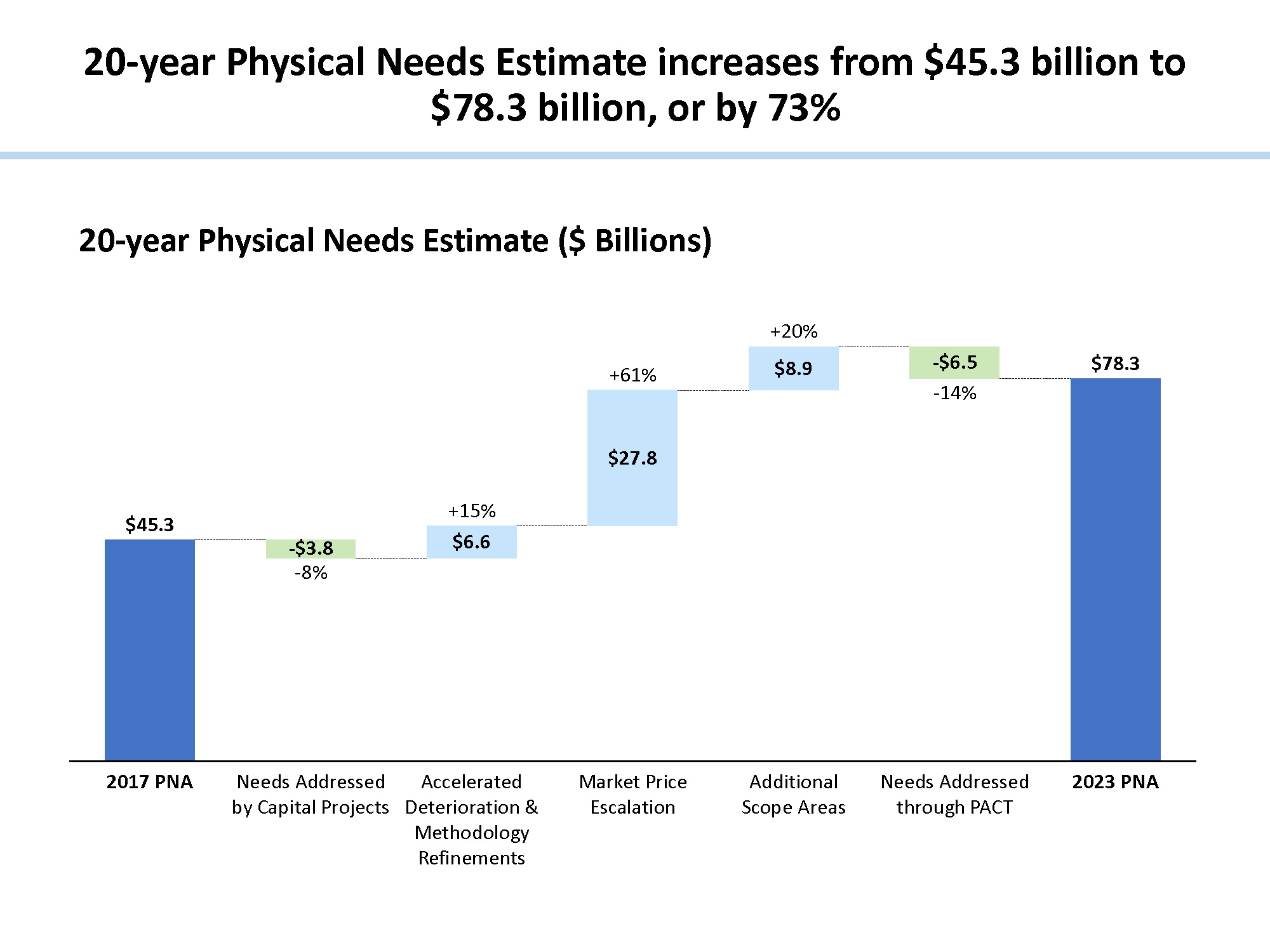
What portion of the physical needs identified should be addressed in the short term?
Fifty-four percent (or $42.1 billion) of the total need identified relates to assets requiring replacement immediately or within the next year, and 77 percent (or $60.3 billion) of the total need identified relates to assets requiring replacement within the next five years. Thus, the majority of the 20-year physical needs should be addressed in the short term.
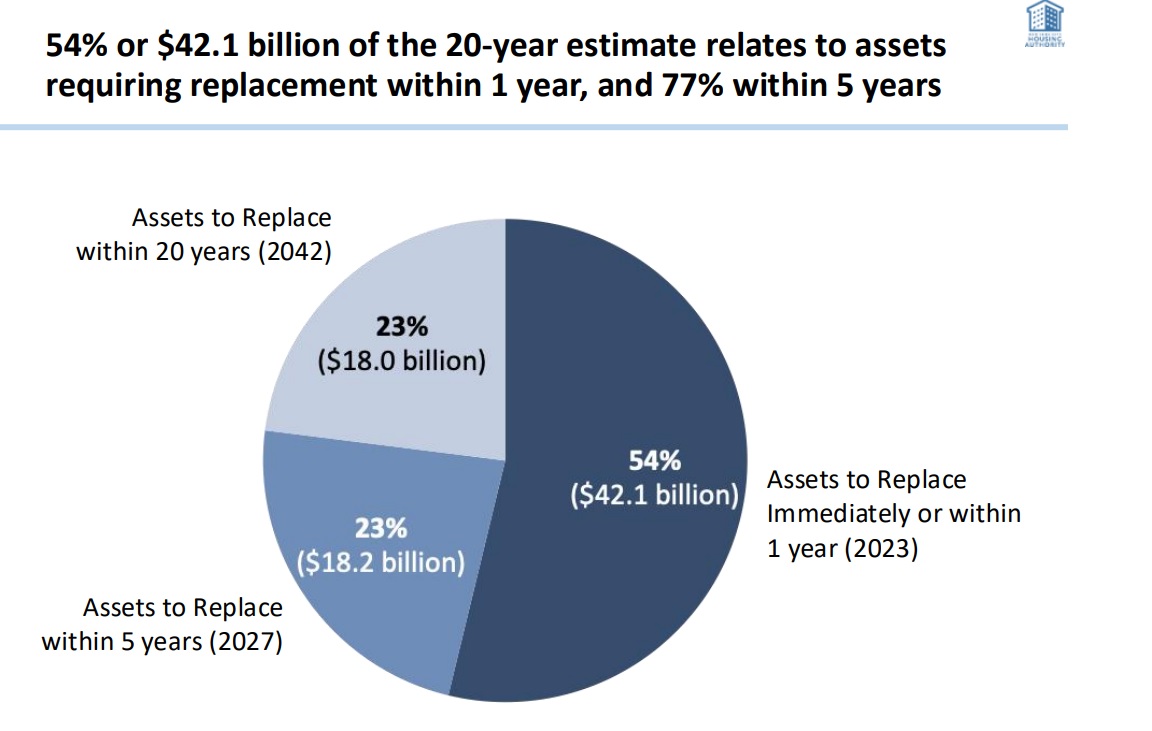
How do the 2023 needs identified break up between different types of physical assets?
Apartments, heating systems, building exteriors, and plumbing account for $57.8 billion (or 74 percent) of the total physical needs. The remaining 26 percent comprise a range of building systems and components, as well as grounds improvements, as shown in the next chart.
The “Apartments Other” category in the chart includes apartment floors, doors, light fixtures, radiators, and electrical panels, while the “Other Areas” category includes waste management, Section 504 apartment renovations, fire protection, and ventilation/air conditioning.
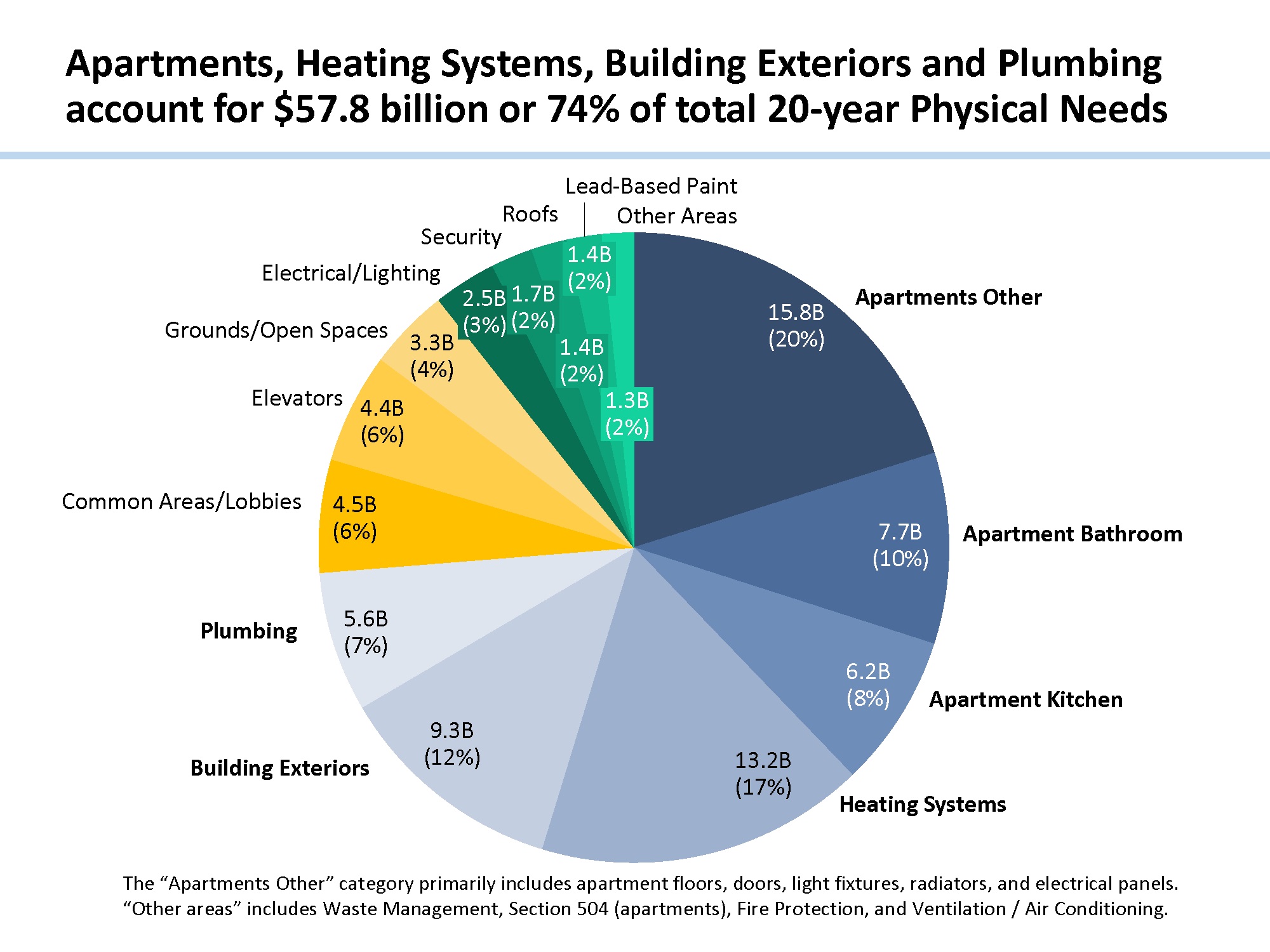
Is the level of physical needs the same at all NYCHA properties?
The level of physical needs can vary significantly among properties. One way to analyze this is to compare the average per-apartment (“per-unit”) physical need estimate among properties, including all physical needs identified at each property (and not only those relating to the apartments specifically). The chart below summarizes the distribution of per-unit physical needs estimates by number of properties, number of units, and percentage of units, in five categories: < $400,000 per-unit needs, $400,0000 to $500,000 per-unit needs, etc.
As highlighted on the right-most bar, 98,928 (or 61 percent) of units have less than $500,000 per-unit physical needs, while 62,472 (or 39 percent) have more than $500,000 per-unit physical needs. The average per-unit physical needs estimate across properties is approximately $485,000.
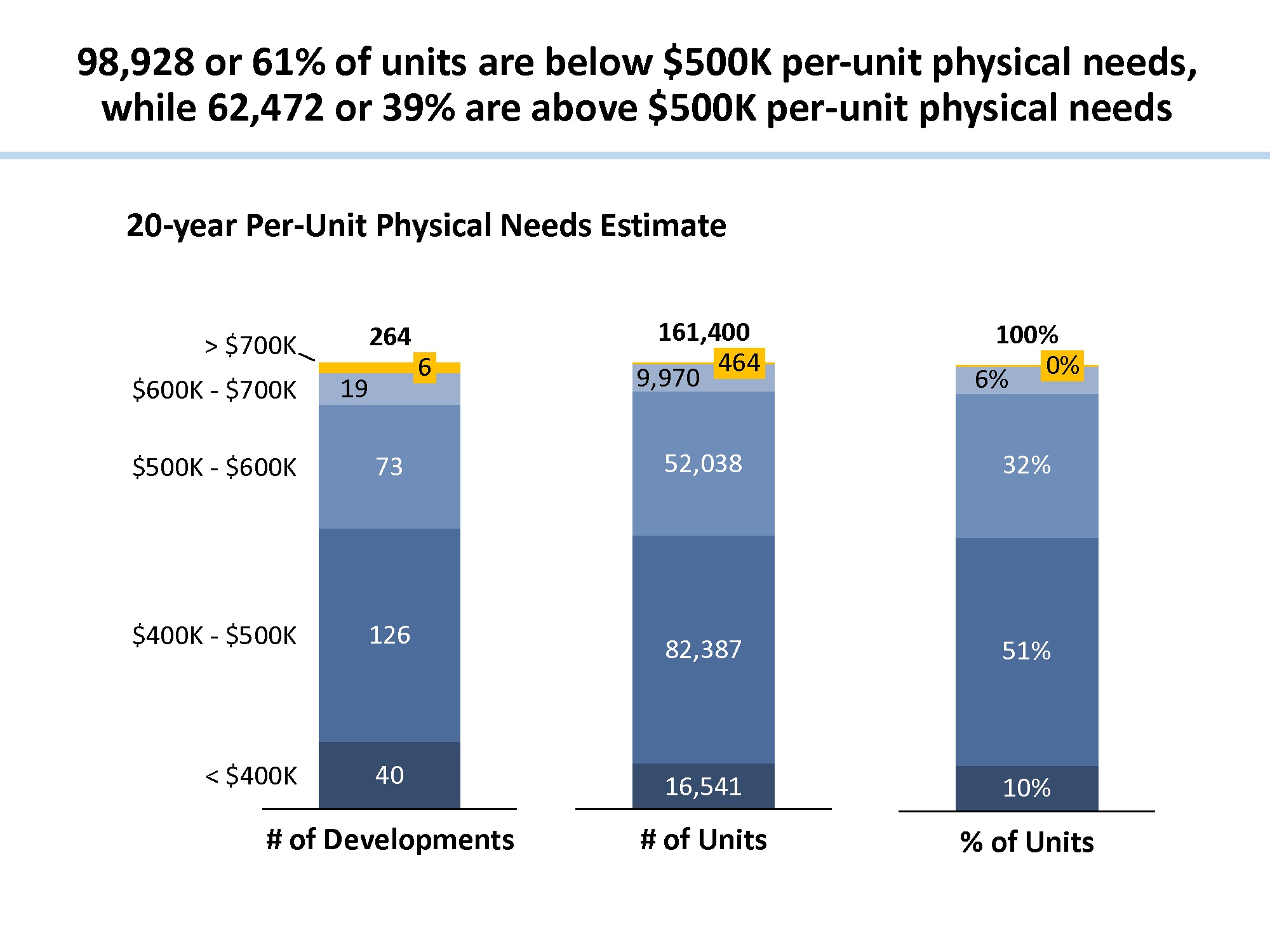
Do the physical needs estimates incorporate future market price changes?
The PNA results are in terms of 2023 market prices and do not incorporate future market price changes, including basic inflation. For this and a number of other important reasons, the PNA estimates are not the same as detailed cost estimates that would be developed in the course of budgeting a capital investment based on the expected market prices at the time of construction. The PNA estimates do, however, capture the magnitude of capital investment required to comprehensively address the conditions of deteriorating physical assets at each property.
Going forward, NYCHA will update the 2023 PNA results on an annual basis. This will ensure that NYCHA can reflect both increases in needs due to market price escalation or other causes, as well as needs addressed through completed capital projects and other programs.
How does NYCHA plan to address the physical needs identified through the PNA?
NYCHA estimates that approximately $38 billion (or 49 percent) of the 20-year PNA estimate can be addressed through ongoing and planned capital projects, the PACT program, and the Public Housing Preservation Trust. This is shown in the chart below.
NYCHA has over 750 ongoing and planned capital projects focused on individual building systems and components or comprehensive modernization of properties. The PACT program transitions developments from traditional public housing assistance to the more stable, federally funded Project-Based Section 8 program, unlocking funding for designated PACT partners to complete comprehensive repairs. NYCHA aims to convert an additional 47,000 apartments through the PACT program. The Public Housing Preservation Trust law currently allows for 25,000 apartments to be comprehensively renovated through a similar model.
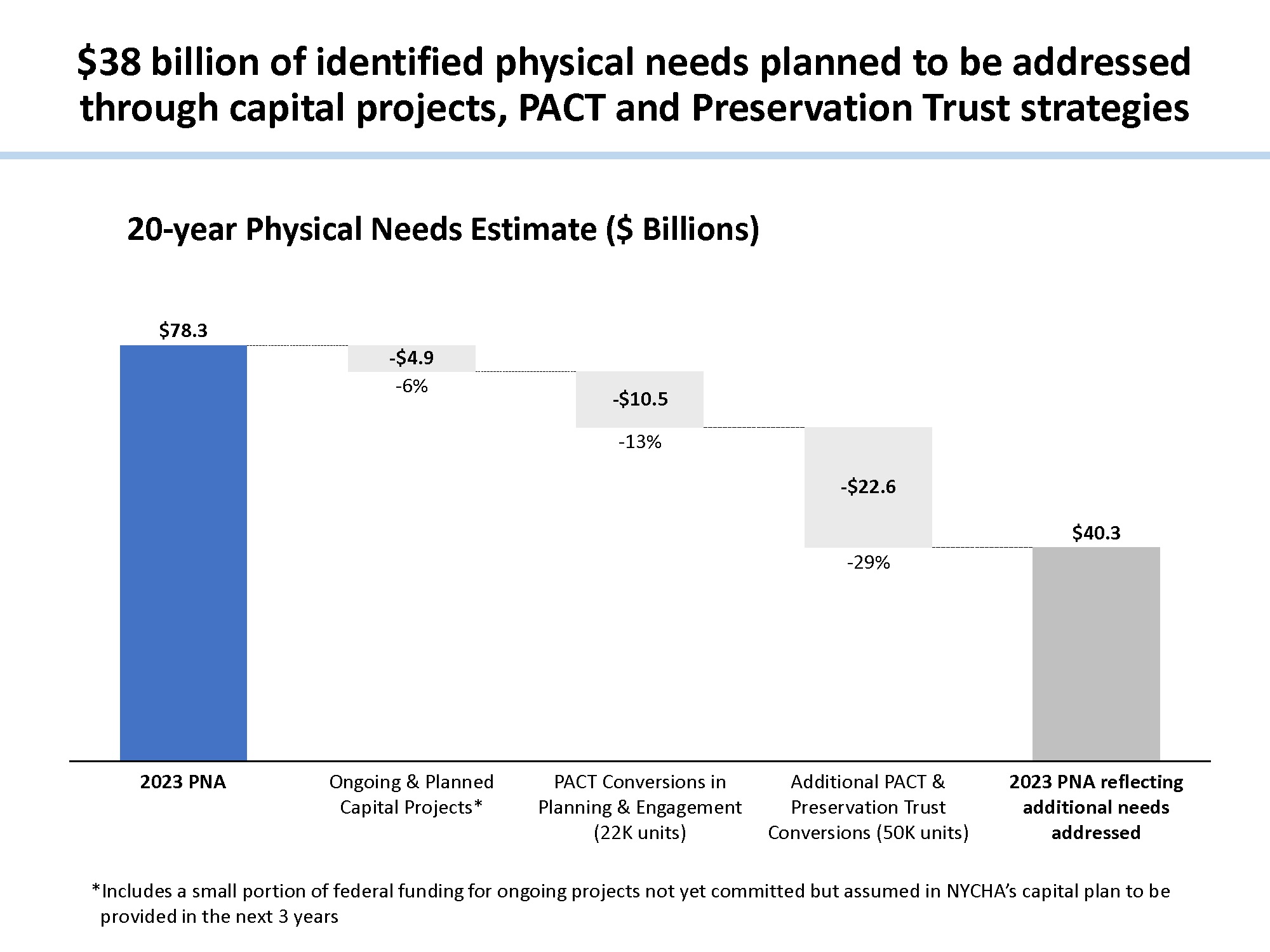
Where can I get more details on the 2023 PNA?
The PNA Technical Report and data file can be found on the “Modernizing NYCHA Properties” page on NYCHA’s website.



